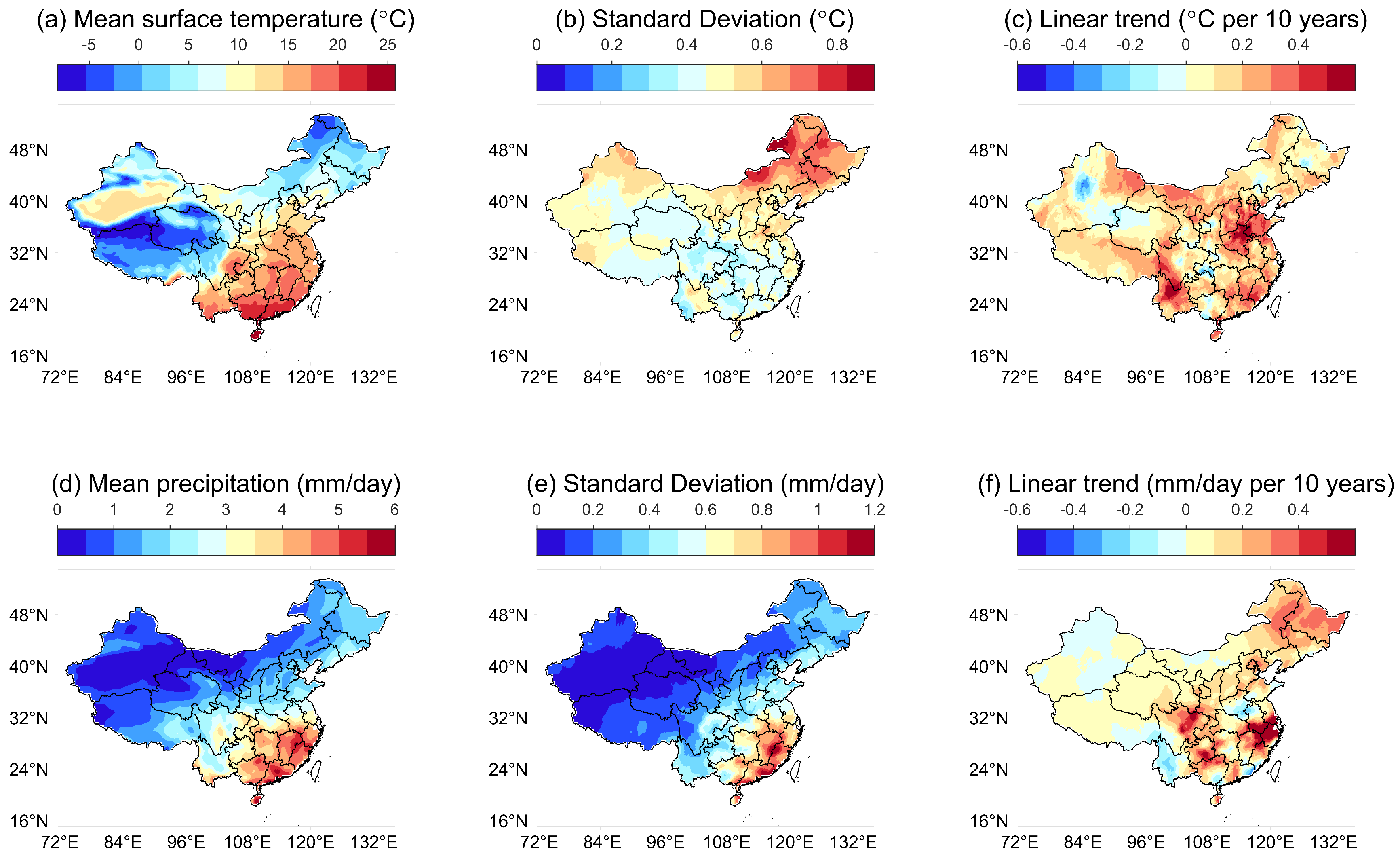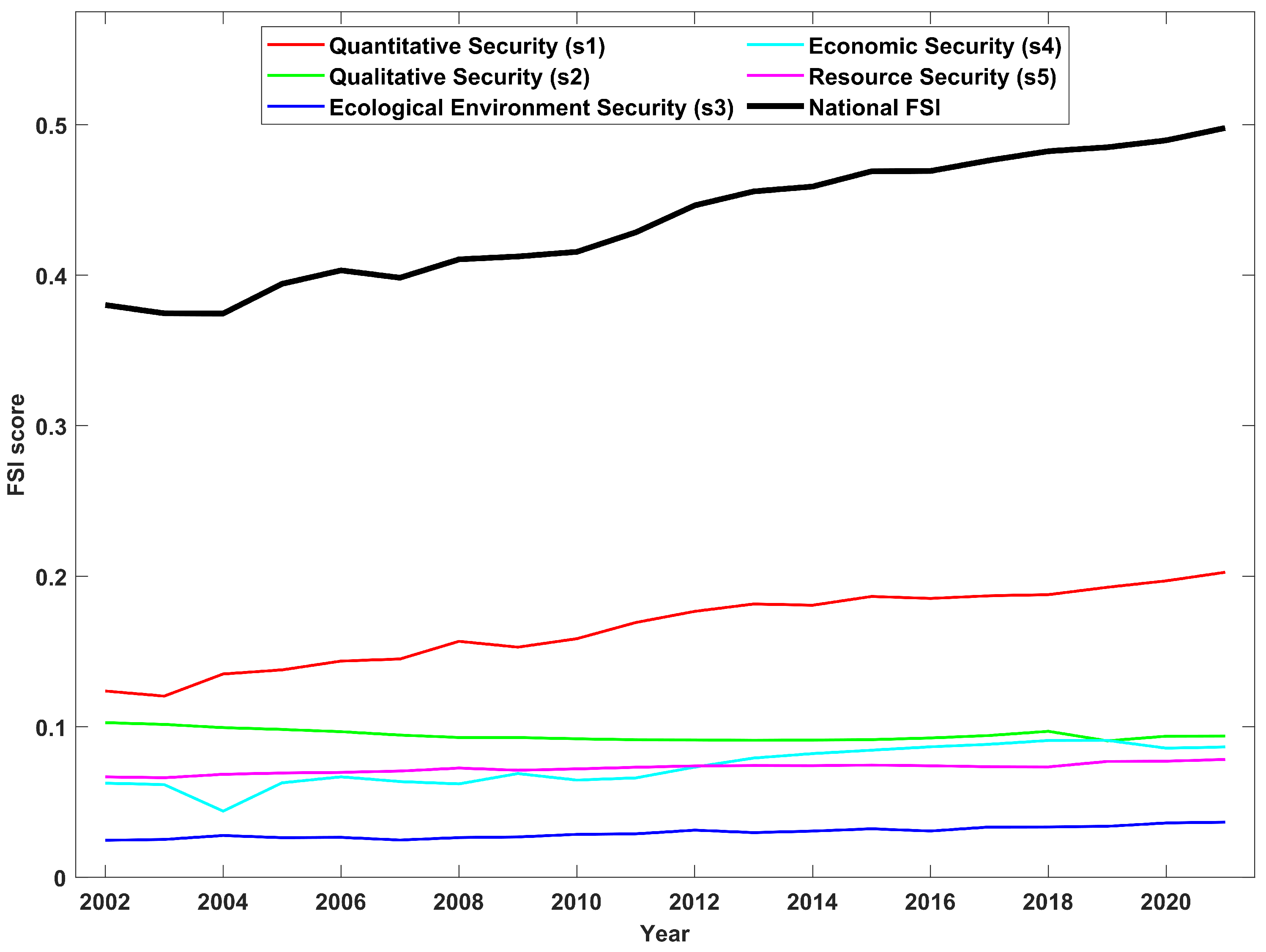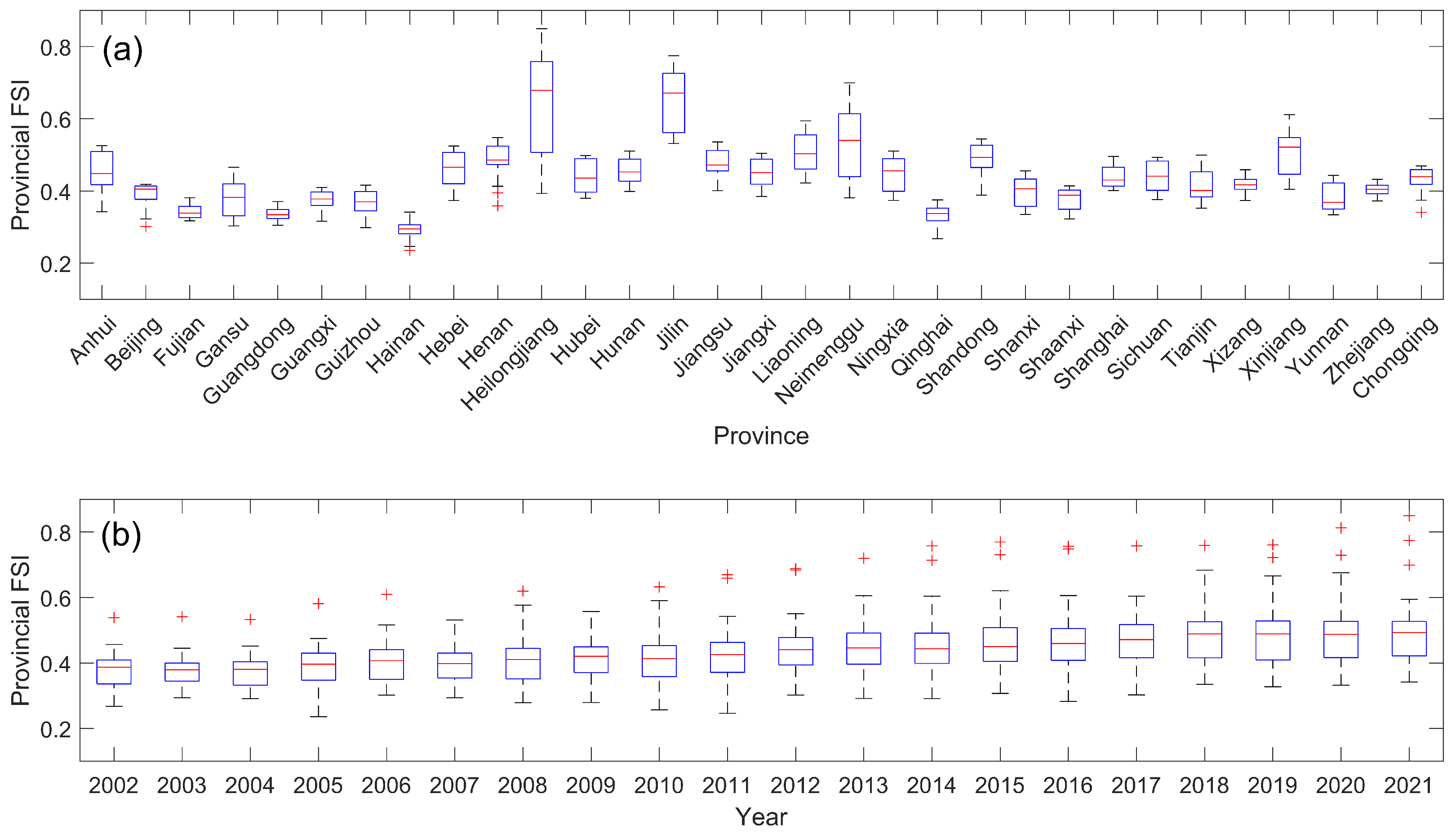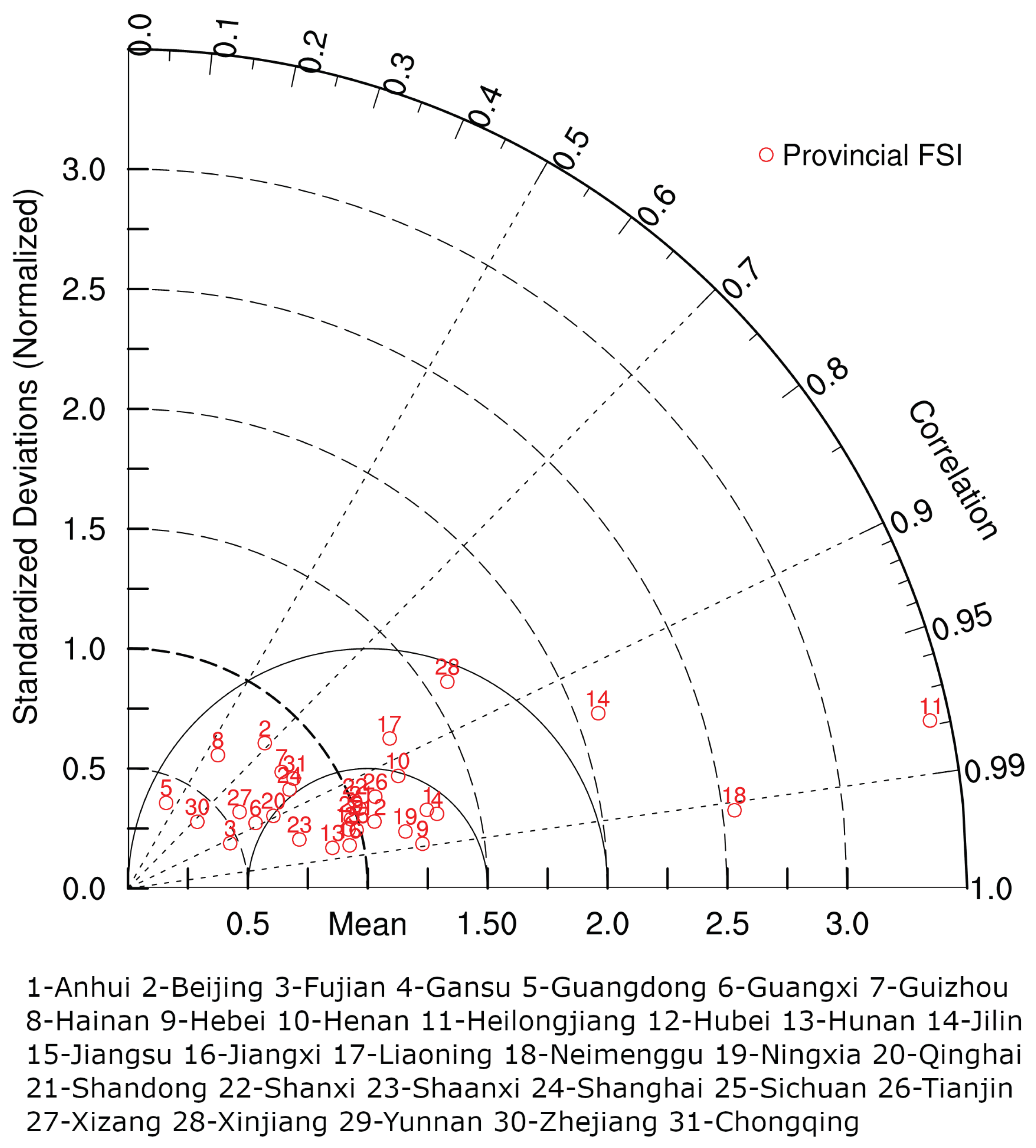1. Introduction
Climate change poses a great challenge to global food security and current changes in global food insecurity can be plausibly attributed to climate change [
1,
2]. Numerous studies have discussed the impact of climate change on various aspects of food security, including the quality of agricultural products [
3], the impact on prices [
4], as well as the impact on agricultural production environments such as farmland [
5,
6], agricultural water use [
7], and agricultural ecosystems [
8,
9]. In fact, the global food security situation is currently facing unprecedented challenges, with nations experiencing an increase in systemic food security risks [
10,
11]. According to the 2022 State of Food Security and Nutrition in the World report released by the United Nations Food and Agriculture Organization [
12], food security issues still exist widely, especially against the backdrop of changing climates. Climate change and extreme climate events have become one of the main contributors to the worsening of global hunger conditions, seriously affecting all aspects of food security, including food supply, access, utilization, and stability.
As the world’s largest producer and consumer of food, China supports nearly 20% of the global population with only 9% of the world’s cultivated land and 6% of freshwater resources [
13,
14]. Food security has always been seen as China’s most important issue related to people’s livelihood, as well as a crucial foundation for economic development, social stability, and national security. However, with rising temperatures, frequent extreme weather events, and changes in precipitation patterns, China’s food production and supply chain are facing increasingly severe threats of climate change, bringing more uncertainty risks [
15,
16,
17,
18]. The government implements comprehensive strategies to ensure the stability and continuous improvement of food security through technological advancement, land protection, subsidies, food reserves, market regulation, agricultural insurance, and international cooperation. Climate in China typically varies significantly across regions due to its vast land area and diverse climatic. Therefore, understanding the multi-dimensional impacts of climate change on China’s food security is crucial.
The concept of food security has undergone three significant evolutions internationally [
19]. In 1974, the Food and Agriculture Organization of the United Nations (FAO) defined food security as "the ability of all people, at all times, to access enough food for an active and healthy life." This definition emphasized quantitative security. In 1983, the definition evolved further to include affordability, emphasizing economic security, particularly for low-income groups. At the 1996 World Food Summit, it raised that "food security exists when all people, at all times, have physical and economic access to sufficient safe and nutritious food that meets their dietary needs and food preferences for an active and healthy life," highlighting nutrition and health. Across the world, there are mainly two authoritative international organizations for food security evaluation are the FAO and the Economist Intelligence Unit (EIU). The FAO’s food security evaluation system mainly focuses on individual nutritional status [
12], constructed from four dimensions: food supply level, food availability, food utilization level, and stability. The EIU’s food security index (the Global Food Security Index, GFSI) focuses the categories of affordability, availability, and quality and safety [
20], and and it holds global significance as a demonstrative tool.
Food security level is impacted by various natural and human factors, and there are many relevant studies. Study on spatio-temporal evolution and scale differences of food security risk patterns in China [
21] have provided a comprehensive analysis of the evolving risk patterns and their implications for policy-making and risk management. Zhang et al. (2022) [
22] explored the spatio-temporal evolution and coordination of agricultural green efficiency and food security in China. A quantitative evaluation of future food security risk considering water scarcity as a key factor is conducted [
23], which highlighted the importance of water resources in ensuring food security and the need for effective water management strategies. The relationship between gross primary production, solar-induced chlorophyll fluorescence, terrestrial water storage, crop grain production, and agricultural investment and policy are examined [
24], providing insights into the complex interactions between these factors and their impact on food security. Focusing on the interaction between food production security and agricultural ecological protection, Liu et al. (2023) [
25] emphasized the need for a balanced approach that considers both food production and ecological sustainability. The work on the impact of low-intensity pollution on China’s sustainable development of food security highlighted the role of pollution in compromising food security and the need for effective pollution control measures [
26]. Yang and Cui (2023) [
27] discussed the balance between feed grain security and meat security, examining the trade-offs and synergies between the two. Zhang et al. (2023) [
28] assessed the impacts of global climate change on water and food security in the black soil region of Northeast China using an improved SWAT-CO2 model. Their findings provided insights into the potential impacts of climate change on water resources and food production in this region, highlighting the need for adaptive measures to mitigate these impacts.
Based on this, it is crucial for assessing global and regional food security to establish appropriate food security evaluation indicators. Heady and Ecker (2013) [
29] suggested concentrating on four key indicators: calories, poverty, dietary diversity, and subjective indicators. In contrast, Coates (2013) [
30] advocated for the utilization of five dimensions: food sufficiency, nutrient adequacy, cultural acceptability, safety, and certainty and stability. Domestic scholars have constructed food security evaluation systems based on China’s national conditions. These systems have evolved from a single focus on supply-demand balance to emphasizing food availability, especially for low-income groups, and then to focusing on ecological and resource security, as well as dietary nutrition and health. Representative scholars and their research include: Zhang et al. (2015) [
31] constructed an indicator system covering eight aspects, including supply, distribution, consumption, utilization efficiency, security outcomes, stability, sustainability, and regulatory capacity. Wang et al. (2022) [
32] established a food security evaluation system from the perspective of food security guarantee capabilities, covering five dimensions: basic guarantee capabilities, market regulation capabilities, production supply capabilities, utilization of international market resources, and agricultural modernization development capabilities. Gao and Zhao (2023) [
33] proposed strengthening the foundation of food security from multiple aspects such as total quantity security, quality improvement, structural optimization, ecological sustainability, and supply diversification. These studies have provided a useful theoretical foundation for understanding the multi-dimensional impacts of climate change on China’s food security.
Most studies on food security systems primarily focused on grain production, supply and demand, and distribution, with a strong emphasis on quantitative food security. However, as economic and social development progressed, food security was given new connotations and objectives. In the contemporary era, the concept of food security has broadened to encompass not only ensuring production capacity but also promoting nutritional, green, diverse, and open food production. This implies safeguarding both quantitative and qualitative food security while maintaining environmental friendliness, economic efficiency in food production, and high resource utilization efficiency. A recent work by Cui and Nie (2019) [
34] proposed a comprehensive food security evaluation system encompassing five dimensions: quantitative security, qualitative security, ecological environmental security, economic security, and resource security. Building upon this framework, the present study has refined and improved the food security evaluation indicator system, aiming to provide a more holistic and comprehensive assessment of food security in the modern context.
Therefore, based on inter-provincial panel data, this study constructs multi-dimensional food security evaluation indicators to explore the mechanism and actual impact of climate change on food security, and analyzes the regional differences in the impact of climate change on food security in different regions. The entropy method is employed to determine the weights of indicators and calculate the
for each province in China. A model of economy-climate as the C-D-C model [
35,
36] is introduced to assess the multi-dimensional impacts of climate change on China’s food security. This work will complement the existing evidence of factors influencing food security, help the Chinese government formulate more comprehensive and targeted policies and measures, provide useful policy insights for addressing the complex challenges of climate change to China’s food security, and ensure the sustainability and safety of China’s food supply.
2. Materials and Methods
2.1. Climate Data Source
The climate data used in this study come from the CN05.1 gridded observation dataset developed and released by the China’s National Climate Center [
37]. This dataset is based on daily observation data from more than 2,400 national stations (basic, benchmark, and general stations) of the National Meteorological Information Center. The variables included are: daily mean temperature, precipitation, maximum temperature, minimum temperature, mean wind speed, relative humidity, and evaporation. In this study, the annual average temperature, annual precipitation, accumulated temperature above
C (Tm10), extreme high temperature index (TX90p, Percentage of days when daily maximum temperature
percentile) , and extreme precipitation index (R95TOT: Accumulation of summer precipitation when daily precipitation
percentile) are calculated using these variables.
2.2. Agricultural Data Source and China’s Grain Regional Division
The provincial agricultural data utilized in this study consist of two main components. Firstly, the construction of food security index data encompasses various metrics, including grain production volatility, grain yield per unit area, per capita grain production, pesticide and fertilizer usage per unit of cultivated land area, proportion of grain affected by disasters, grain consumer price index, Engel’s coefficient for rural residents, cultivated land area per unit of grain production, and water resources used per unit of grain production. Secondly, agricultural input data comprises planted area, effective irrigation area, total agricultural machinery power. These datasets are sourced from multiple authorities such as the National Bureau of Statistics, provincial statistics bureaus, the China Economic Data website, the National Intellectual Property Administration, the "China Statistical Yearbook," the "China Rural Statistical Yearbook," and provincial statistical yearbooks, primarily accessed through the publicly available website
https://data.stats.gov.cn/. Owing to data unavailability and to ensure research feasibility, data from the Hong Kong, Macau, and Taiwan regions were excluded from this study.
According to China’s grain regional division, 31 provinces can be divided into three regions, namely, the main grain-production area (MPA), the main grain-consumption area (MCA), and the producing-consumption balance area (BA). The MPA refers to the key grain production areas with geographical, soil, climate, technological, and other advantages, which are suitable for planting certain grain crops and have certain resource advantages, technological advantages, and economic benefits, including 13 provinces (Heilongjiang, Jilin, Liaoning, Neimenggu, Hebei, Henan, Shandong, Jiangsu, Anhui, Jiangxi, Hubei, Hunan, and Sichuan). The MCA refers to the grain consumption area with relatively developed economy, but with a large population and limited land resources, low self-sufficiency rate of grain, and a large gap between grain production and demand. It is mainly concentrated in the southeastern coastal areas and big cities, including 7 provinces (Beijing, Tianjin, Shanghai, Zhejiang, Fujian, Guangdong, and Hainan). The BA refers to the provinces that contribute limitedly to the national grain production but can basically maintain self-sufficiency, including 11 provinces (Shanxi, Ningxia, Qinghai, Gansu, Xizang, Yunnan, Guizhou, Chongqing, Guangxi, Shaanxi, and Xinjiang).
2.3. The Establishment of Food Security Indicator System
When measuring the food security level of each province in China, the entropy method is used to determine the weights of the three-level indicators of the food security evaluation indicator system as is shown in
Table 1, and the food security index of each province is calculated accordingly.
2.3.1. Detailed Explanation of the Indicators
Firstly, the Quantitative Security (s1) solves the problem of whether people can "eat enough", directly reflecting the level of grain supply. It is the foundation and most important indicator of food security. In this work, three indicators are selected as follows, both of which are positive indicators:
Grain Production Fluctuation Rate (%) . It refers to the measure of changes in grain production over a specific period of time indicating the stability or variability of grain production from year to year.
Grain Yield per Unit Area (kg/hectare). It measures the grain production efficiency of a region.
Per Capita Grain Production (kg). It refers to the average amount of grain produced per person in a given region or country.
Secondly, Qualitative Security (s2) measures the issue of whether people can "eat safely and healthily". This article selects two indicators, both negative, as follows:
Pesticide Usage per Unit of Cultivated Area (kg/hectare). It measures the amount of pesticide applied to a specific area of landr reflecting the intensity of pesticide applications.
Fertilizer Usage per Unit of Cultivated Area (Pure Quantity, kg/hectare). It refers to the quantity of fertilizers applied to a specific land area. Fertilizer is known as the "food" of grain, mainly used to improve soil fertility and land yield per unit area. However, excessive application of fertilizer leads to a decrease in soil organic matter, soil hardening, a decrease in land quality, and pollution of irrigation water.
Thirdly, Ecological Environment Security (s3) examines the sustainability of food production. Food production should not only consider whether the current food production and quality can meet the needs of contemporary people, but also investigate the sustainability of resources. The Grain Disaster Rate is selected as follows:
Grain Disaster Rate (%). It measures the impact and response capabilities of each province to diseases, pests, and climate disasters through the proportion of food crops affected by disasters.
Table 1.
Food Security Indicator System involved in this study.
Table 1.
Food Security Indicator System involved in this study.
| Tier 1 Indicator |
Tier 2 Indicator |
Tier 3 Indicator |
Indicator Direction* |
Food Security Index
(FSI) |
Quantitative Security
(s1) |
j1: Grain Production Fluctuation Rate (%) |
Positive |
| j2: Grain Yield per Unit Area (kg/hectare) |
Positive |
| j3: Per Capita Grain Production (kg) |
Positive |
| Qualitative Security (s2) |
j4: Pesticide Usage per Unit of Cultivated Area (kg/hectare) |
Negative |
| j5: Fertilizer Usage per Unit of Cultivated Area (Pure Quantity, kg/hectare) |
Negative |
| |
Ecological Environment
Security (s3) |
j6: Grain Disaster Rate (%) |
Negative |
| |
Economic Security
(s4) |
j7: Consumer Price Index for Grain Products (Previous Year = 100) |
Negative |
| |
|
j8: Rural Residents’ Engel Coefficient (%) |
Negative |
| |
Resource Security
(s5) |
j9: Cultivated Area Used per Unit of Grain Production (hectare/ton) |
Negative |
| |
|
j10: Water Resources Used per Unit of Grain Production (cubic meters/ton) |
Negative |
Then, Economic Security (s4) measures whether people can "afford" to eat. This work selects two negative indicators as follows:
Consumer Price Index for Grain Products (Previous Year = 100). It is a measure that tracks changes in the prices of grain-related products consumed by the general population.
Rural Residents’ Engel Coefficient (%). It refers to the proportion of food expenditure in the total consumption expenditure of rural households. This coefficient provides insights into the living standards and consumption patterns of rural residents.
Lastly, Resource Security (s5) examines the resource occupation of food production. This article selects two negative indicators as follows:
Cultivated Area Used per Unit of Grain Production (hectare/ton). It refers to the amount of land required to produce a certain quantity of grain. It is a measure that indicates the efficiency of land use in grain production.
Water Resources Used per Unit of Grain Production (cubic meters/ton). It refers to the amount of water consumed in the production of a specific quantity of grain. This metric is crucial in assessing the water efficiency of agricultural systems and the sustainability of grain production practices.
2.3.2. The Entropy Weight Method
The entropy weight method is a commonly used approach for evaluating the effectiveness of multiple attributes or criteria in decision-making problems. It is based on the concept of entropy from information theory, which measures the uncertainty or the amount of information contained in a random variable or a set of data. In the entropy weight method, the entropy value of each evaluation criterion is calculated. This entropy value reflects the degree of dispersion or uncertainty associated with the data for that criterion. The weights of the criteria are then determined based on their entropy values. Criteria with higher entropy values (indicating greater uncertainty or dispersion) are assigned lower weights, while criteria with lower entropy values (indicating less uncertainty or dispersion) are assigned higher weights. The method provides a quantitative measure of the contribution of each criterion to the overall decision result. It is often used in multi-attribute decision-making problems where there are multiple criteria or indicators that need to be considered simultaneously.
In this work, the entropy weight method the entropy weight method is performed to determine the weight of each indicators in the Food Security Indicator System in
Table 1. Detailed steps of how to perform this method can be seen in section
Appendix A.1.
2.4. The Panel Data Analysis Method
Panel Data Analysis is a statistical technique used to analyze data that combines both cross-sectional and time-series dimensions. This type of data, often referred to as "panel data" or "longitudinal data," involves observations of multiple entities across multiple time periods. It can be used to estimate the effects of time-invariant and time-varying explanatory variables on a dependent variable, taking into account both the cross-sectional and time-series dimensions of the data. The analysis typically involves fitting a regression model to the panel data, where the dependent variable is regressed on a set of explanatory variables. Panel regression analysis has a wide range of applications in various fields, including economics, finance, sociology, and political science. It is particularly useful when studying processes that involve both individual and time-varying factors, such as economic growth, firm performance, or social change.
In this work, a climate-economic model is used to assess the multi-dimensional impacts of climate change on China’s food security. The establishment of this model can be seen in section
Appendix A.2.
4. Discussion
The assessment of food security in China is a multifaceted and intricate process, heavily influenced by regional disparities and varying policy frameworks. The complexity of the subject has led to the development of distinct indicator systems reflecting individual research priorities, which may yield differing conclusions when evaluating the nation’s food security status. This study presents a holistic framework for food security analysis that encompasses five key dimensions: Quantitative Security, Qualitative Security, Ecological Environmental Security, Economic Security, and Resource Security. This robust structure builds upon and refines existing indicators, aiming to offer a more integrated and thorough understanding of food security in light of current challenges and dynamics.
Quantitative Security accounts for a critical 63% weight within China’s Food Security Index (FSI). Over time, there has been a general strengthening of China’s food security, with strong positive correlations observed for Quantitative, Ecological Environment, Economic, and Resource Security aspects. However, the decline in Qualitative Security, as indicated by its negative correlation, highlights the vital need for persistent improvements in grain production efficiency and strict adherence to cultivated land red line policies. Core strategies include advancing agricultural technologies, judicious land use management, and stringent protection against overexploitation to ensure sustainable food output and resilience to adversities.
A closer examination of
Figure 3 reveals that among the 31 provinces studied, five provinces—Shaanxi, Guizhou, Xizang, Gansu, and Qinghai—in balanced production-consumption regions exhibit notably low food security scores, signifying heightened insecurity and significant challenges to national food security. These regions, characterized by less fertile lands and underdeveloped infrastructure, are prime targets for agricultural improvement initiatives. In response to intensifying food security risks in these balance zones, urgent and comprehensive action is required. This involves enhancing agricultural productivity, protecting arable land, augmenting grain reserves, optimizing logistics, establishing robust emergency plans, promoting climate-smart agriculture, encouraging moderate-scale farming, and implementing targeted support measures. These strategic steps are indispensable for maintaining stable grain supplies and reinforcing national food security amidst growing threats from climate change, dwindling land resources, and volatile market conditions.
Climate change, marked by rising temperatures and more frequent extreme heat events, significantly impacts China’s food security landscape. Precipitation influences display a U-shaped pattern, initially benefiting food production until it reaches a point where excessive levels become detrimental. Therefore, local food security strategies must be adapted to address climate change by assessing regional climate risks, diversifying agricultural outputs, optimally allocating water resources, upgrading agricultural facilities, promoting resilient farming practices, bolstering community resilience, and fostering collaboration across stakeholders to enhance adaptive capabilities. Upholding the red line for cultivated land, improving soil quality, and endorsing moderate-scale farming operations are fundamental elements to strengthen the stability and resilience of agricultural production under an evolving climate scenario.
5. Conclusions
To conduct a comprehensive quantitative assessment of China’s food security, this study devised a provincial Food Security Index () system consisting of five secondary indicators and ten tertiary indicators. The entropy method was employed to assign weights and compute the for each province. Leveraging a climate-economic model, the investigation scrutinized the multifaceted impacts of climate change on China’s food security landscape over the 2002-2021 period, culminating in several noteworthy findings.
China’s diverse climates exhibit increasing temperatures and variable precipitation patterns, with the most significant warming trends observed in its northern, central, and southwestern regions. Southern provinces receive higher annual rainfall due to monsoons, whereas interannual fluctuations in southeast regions elevate the likelihood of drought occurrences.
Quantitative Security elements account for a dominant share (63%) within the overall , which has generally exhibited improvement across multiple dimensions, except for Qualitative Security, which experienced a downturn. While provincial food security levels have improved collectively, they are notably under threat in BA designated areas.
Statistical regression analyses uncovered a robust negative linear relationship between accumulated temperatures () and provincial food security, demonstrating statistical significance at p<0.01. Precipitation, conversely, influences food security in a non-linear fashion, manifesting as an inverse U-shaped curve that becomes substantial when surpassing certain thresholds, particularly in MPA and MCA zones.
Extreme high temperatures consistently lower food security across multiple indicators, while no such linear correlation exists for extreme precipitation. However, there’s a statistically significant inverse U-shaped association between extreme precipitation and food security.
In the specific context of the BA region, exert a significantly detrimental effect on food security, contrasting sharply with the positive correlation found between and food security, a relationship that appears more pronounced in BA compared to MPA. Further, non-linear analyses divulge that beyond certain thresholds, escalating precipitation can lead to diminishing returns or even adverse effects on food security.









